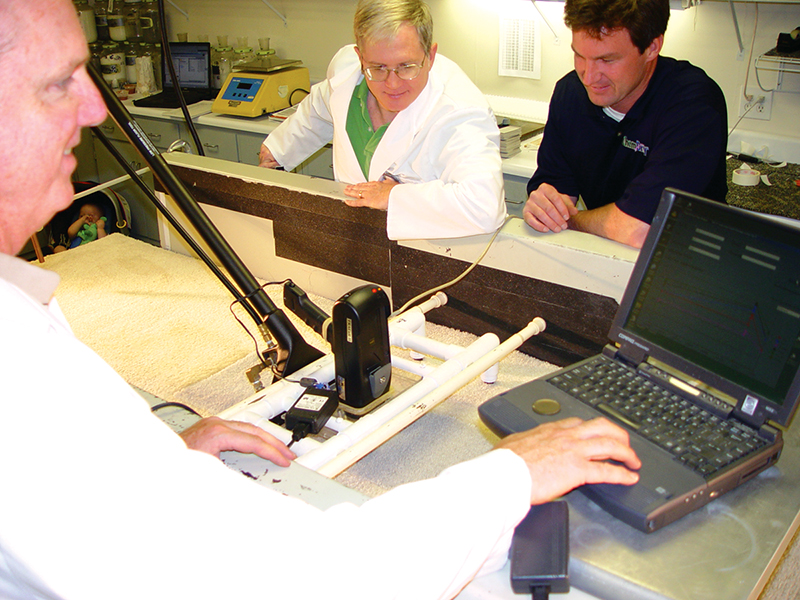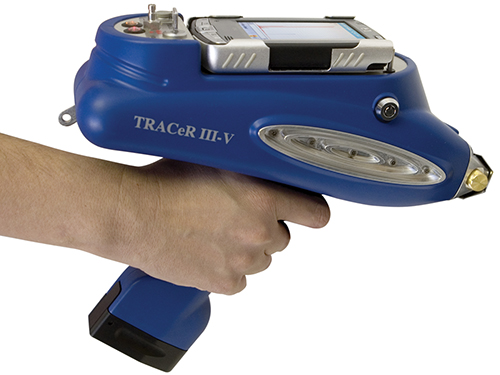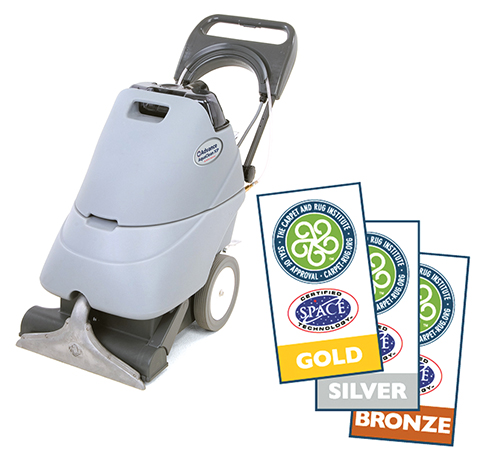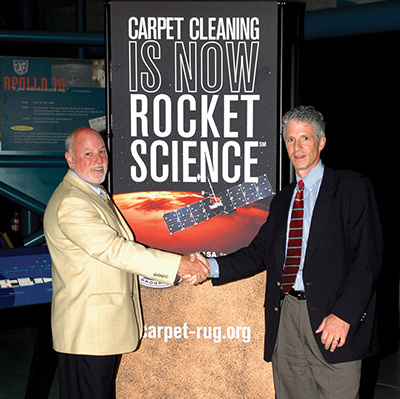
X-ray Device Makes Scrubbing Rugs Clean a Spotless Effort
Originating Technology/NASA Contribution
If “pulling the rug out from under” means suddenly withdrawing support and assistance, then NASA is pretty good at “putting the rug under” when it comes to offering technical support and assistance to private industry. In the case of a new X-ray fluorescence (XRF) sensor featuring enhancements compliments of NASA, the Space Agency not only provided the rug, but helped give private industry a means to ensure it keeps clean.
This sensor, utilized by NASA to read chemical bar codes concealed by paint and other coatings, perform on-the-spot chemical analyses in field conditions, and detect difficult-to-identify contaminants, has found another use as a tool that can measure how much soil is removed from household and commercial carpets.
The original technology was developed in 2002 to conduct quality control for critical aluminum alloy parts destined for the space shuttle. Evaluation of these parts is critical for the Space Agency, as any signs of contamination, corrosion, or material deviation could compromise a shuttle mission.
Partnership
In the summer of 2001, NASA began seeking a company that could design and manufacture a lightweight, hand-held scanner capable of detecting data matrix symbols on parts covered by layers of paint and coatings containing various chemicals. The Federal Aviation Administration (FAA) was also looking for this type of technology, to eliminate the use of unapproved parts. (Counterfeit parts, like expended pieces that had been sold for scrap and pieces made by unqualified suppliers, do not fit the criteria for FAA acceptability. Without safeguards, the potential exists for such unapproved items to find their way back into the supply chain. One of the safeguards is to provide a positive identification system for all parts in the FAA system—one that goes beyond the simple marking of a data matrix bar code or human-readable identity on a part.)
In its search, the FAA came across a company named KeyMaster Technologies, Inc., that was willing to let its XRF hand-held scanning technology serve as the basis for new developments. Since the FAA had recently participated with NASA in developing a technical standard for part marking, it recommended NASA and KeyMaster work together to create an anti-counterfeit technology that would benefit both agencies.
KeyMaster agreed to meet with NASA, sharing its opinion that its XRF scanner could be adapted to fit the required needs. Up to this point, the XRF instrument was primarily being used as an alloy analyzer in the metals industry.
In January 2002, KeyMaster visited Marshall Space Flight Center’s Technology Transfer Office to demonstrate the XRF technology. Technical personnel from Marshall’s Engineering and Science Directorates were on hand to witness the demonstration. The XRF demo was convincing, as all of the NASA participants were impressed with the portability of the XRF scanner, its proven ability to quickly analyze the composition of most materials in the Earth’s environment, and its potential to help NASA avoid hardware nonconformance issues. NASA and KeyMaster signed a Space Act Agreement in March 2002, instituting the formal research and development partnership.
Dr. Bruce Kaiser, KeyMaster’s chief technology officer, worked with NASA personnel, guided by Fred Schramm of Marshall’s Technology Transfer Office, to enhance the preexisting XRF scanning technology for NASA’s purposes. During the early stages of development, NASA found that advances were required to extend the XRF instrument’s detection range to include aluminum alloys, since aluminum is used to build the space shuttle, its external tank, parts of the reusable solid rocket motor, and many other shuttle-related components. To extend the detection range, NASA and KeyMaster determined that the air between the X-ray source, the object being evaluated, and the detector would have to be removed, because X-rays emitted by the instrument were strong enough to penetrate the air on the way to the object and stimulate atoms in the substrate, but X-rays returning to the detector were not strong enough to penetrate the air and, therefore, could not be detected. According to Schramm, this was an industry-wide limitation.
First, NASA and KeyMaster needed to conduct a test to gauge whether the air-removal concept was even possible. To do so, the partners placed the XRF instrument inside a vacuum chamber, where it was then used to detect aluminum alloy samples. This proof-of-concept was successful, as the instrument quickly analyzed the samples with ease and precision.
The next step was to devise a way to actually remove the air from the instrument chamber, outside of a vacuum chamber and in a real-life environment, so the return X-rays could travel easily to the detector. By incorporating a vacuum system into the instrument, NASA and KeyMaster arrived at a design that successfully accomplished this. In addition, this new design provided a new capability for detecting low-energy elements.
KeyMaster forged ahead with manufacturing three of the advanced instruments for NASA’s Return to Flight mission. Upon completion, the scanning devices were delivered to NASA’s External Tank Project, Space Shuttle Main Engine, and Reusable Solid Rocket Motor offices.
NASA and KeyMaster filed two patent applications for the finished product, called TRACeR III-V. The first patent pertained to the vacuum-assist element that removes air from the instrument chamber and enables the detection of low-energy elements, like aluminum and magnesium, as well as contaminants within NASA hardware, like silicon. The second patent was for intrinsic product authentication through chemical tag identifiers that are converted to bar code language. This patent was primarily intended for commercial applications, as NASA and KeyMaster had realized the technology’s value in other industries.
Product Outcome
Shaped like a portable drill and weighing less than 5 pounds, TRACeR III-V has found commercial success in bar code identification and chemical analysis. Recently, the technology set the stage for a major breakthrough in carpet cleaning, helping to create stricter standards for today’s vacuum cleaners, to ensure that they are removing soil and stains impervious to conventional cleaning techniques. This breakthrough came courtesy of NASA and KeyMaster, in collaboration with the Carpet and Rug Institute (CRI)—the national trade organization for the carpet and rug industry that represents over 90 percent of all carpeting produced in the United States and offers scientific insight into how carpet and rugs can “create a better environment for living, working, learning, and healing.”
The three organizations worked together to establish a multifaceted testing program that utilizes an XRF-detectable soil media that can be quantified after a carpet cleaning, to measure the effectiveness of a given cleaning system. This designer “soil” contains properties similar to actual soil found in carpeting throughout the country, according to CRI.
Using the TRACeR III-V scanner, laboratories can measure the starting compound applied to a carpet sample and then quantify the precise amount of soil removed following a cleaning. The scanner can additionally be used to determine the amount of water being removed from a carpet during a cleaning, in the event of a spill, or if a wet-vac had been used. To measure how well an extractor (vacuum cleaner) recovers water, a carpet sample is weighed before and after the testing process to determine how much water remained.
Extractors that do not sufficiently remove soil or water from a carpet can increase the potential for growth of mold spores, plus damage the carpet fibers. Add to this the buildup of everyday contaminants that are prevalent in the home, such as dust mites, pet dander, pollen, and other allergens, and the potential for health problems exists.
Compounding these concerns for mold and contaminants is air quality. According to the U.S. Environmental Protection Agency, air within homes and other buildings can be up to 5 times more polluted than outdoor air. “Removing dirt and particles from a carpet and containing them within the canisters of the best performing vacuum helps improve overall air quality,” maintained CRI.
Michael Berry, Ph.D., former deputy director of the National Center for Environmental Assessment of the Environmental Protection Agency and a leading authority on indoor air quality, stated, “In my 30 years’ experience, the XRF taggant technology is the first scientific approach to quantifying carpet cleanliness that I will stand behind 100 percent.”
The XRF testing also evaluates surface-appearance changes in carpeting, as a result of vacuuming. This test is included, because experience has shown that some extraction machines can cause excessive wear on carpet, according to CRI.
Any carpet-cleaning companies that subject their extraction products to CRI’s XRF testing and meet the institute’s strict standards for soil removal, water removal, and surface appearance are awarded a CRI Seal of Approval. Since soil removal is the primary test, efficiency is rated on three levels: extractors that exceed average soil removal receive a Bronze Seal rating; extractors achieving higher soil removal receive a Silver Seal rating; and extractors removing the highest amount of soil measurable receive a Gold Seal rating. So far, more than 30 products have received Seal of Approval certification.
On September 12, 2005, Kennedy Space Center hosted the official launch of CRI’s Seal of Approval program. Several national carpet manufacturers in attendance were honored with the Gold Seal of Approval, including: Sears Carpet & Upholstery Care, of Lewis Center, Ohio; Mohawk FloorCare Essentials, of Fayetteville, Georgia; Prochem, of Englewood, Colorado; ZeroRez, of Lindon, Utah; and CleanMaster Corporation, of Mukilteo, Washington. Two weeks later, on September 23, 2005, the product-testing program was recognized as a Certified Space Technology by the Space Foundation.
In March 2006, CRI announced that it is accepting products for testing under the latest phase of the Seal of Approval program. This new “Deep Cleaning Systems” phase evaluates the combined effectiveness of cleaning equipment and cleaning chemistries.
AquaClean® is a registered trademark of Nilfisk- Advance, Inc.

KeyMaster Technologies, Inc.’s TRACeR III-V portable, hand-held scanner, for detecting and tagging unique elemental codes. This instrument was designed to help NASA evaluate parts destined for the space shuttle.

The Advance AquaClean 16XP carpet extractor, from Nilfisk-Advance, Inc., was honored at the Carpet and Rug Institute’s Seal of Approval program launch at Kennedy Space Center in September 2005.

KeyMaster Technologies, Inc.’s Lloyd Starks (left), special projects consultant, and John Landefeld, chief executive officer, share a handshake at the Seal of Approval program launch.

Researchers at the Carpet and Rug Institute use the TRACeR III-V to test the carpet-cleaning efficiency of a commercial vacuum cleaner. The TRACeR III-V is capable of detecting the amount of soil a vacuum cleaner removes, determining how well an extracting vacuum cleaner recovers water, and determining whether a vacuum cleaner is causing excessive carpet wear.













